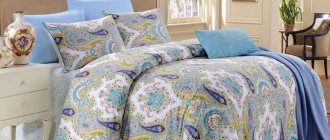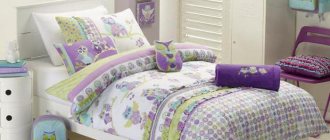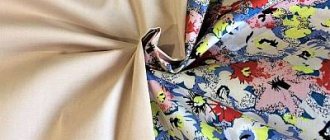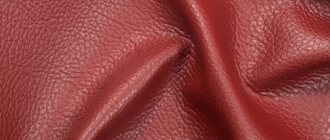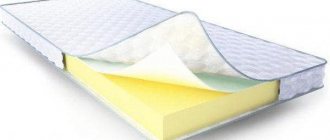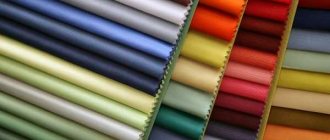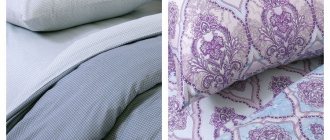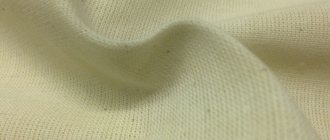Description
What is twill-satin fabric? Visually, you are unlikely to distinguish it from ordinary satin; what distinguishes one material from another is its density. The difference between satin and twill-satin is that in the first case the weave is characterized by a step of one thread to three, and in the second - two to two.
The weaving method makes twill-satin fabric less dense, and therefore more affordable. Otherwise, you won't notice any significant differences. The same shine and gloss, as well as the environmental properties of the material - all this remains unchanged. Therefore, it is difficult to say which is better, it all depends on what is preferable for you - the density of the material or its affordable price. The price per linear meter starts from 135 rubles.
You can see what the matter looks like in the photo.
Description of twill-satin: how does the fabric differ from regular satin?
What is the difference between twill-satin (twill-satin is a misspelling) and classic satin? Externally, these tissues cannot be distinguished from each other with the naked eye. Their main difference is the amount of fibers used in the manufacturing process. When producing standard satin, there are 4 warp threads per 1 weft thread. When making twill satin, an equal number of weft and warp threads are used - 2 each (less often 3). Due to this, twill-satin fabric is less durable and, accordingly, cheaper than satin.
Cotton twill satin
This fabric is produced using twill or diagonal weave, in which the weft and warp are intertwined at a constant pitch. Each subsequent row of fabric is shifted by one thread, resulting in a diagonal rib. As a rule, when producing this type of fabric, in addition to cotton raw materials, additional fibers are included in the composition of the fabric - polyester, elastane, wool, silk. There are many varieties of this fabric. General information about them is presented in the table:
Twill stretch
| Classification method | Types of twill-satin | Characteristics |
| By composition | Cotton | This is an absolutely natural product of the textile industry. Due to its high hygienic properties, it is widely used for sewing summer clothes. |
| Silk (twill stretch) | To give the fabric elasticity, its composition includes from 2 to 5% elastane or lycra. This material feels like silk to the touch. | |
| Mixed | It is obtained by combining cotton raw materials with synthetic fibers in various proportions. This fabric is often used for sewing suits, uniforms, workwear, jackets, and raincoats. To impart water-repellent and windproof properties to the surface of products made from mixed fabric, a polyurethane coating is applied to the fabric on the reverse side before sewing. | |
| By dyeing method | Mullined | Multi-colored twisted threads are used. |
| Plain painted | The canvas is painted in one color. | |
| Melange | 2 shades combined. | |
| Printed | Prints (patterns or designs) are applied to the material. |
Printed twill satin
Features and types of twill
The answer to the question of what kind of twill fabric there is and what it is lies in the peculiarities of its weave. In twill fabric, similar to twill, the weft threads intersect with the warp at a specific pitch, which moves one thread at each subsequent pass. As a result, a characteristic diagonal scar is formed on the surface of the material. The peculiarity of twill is that for each step the number of warp and weft threads is the same. Usually it is 2/2, less often 3/3. Twill material has the following characteristics:
- density combined with softness;
- light shine, which depends on the level of twist of the thread;
- textured surface with diagonal relief;
- dimensional stability;
- drapeability;
- strength and wear resistance;
- breathability and at the same time the ability to filter dust;
- low creasing and easy ironing;
- resistance to repeated washing;
- quick drying;
- practicality.
Most often, this material is produced plain-dyed, although sometimes prints, mainly camouflage, are also applied.
However, when purchasing twill, you need to pay close attention to the description of the composition, since it can vary significantly for modern fabrics. On sale you can find textiles of the following composition:
- cotton, also known as twill-satin;
- silk (with the addition of 5% elastane), which is an elite textile;
- woolen, belonging to the tweed group;
- mixed, which is most widely available on sale at present.
Compound
The final cost of twill-satin depends on the raw materials present in the composition. And there is plenty to choose from:
- Typically, twill-satin material is made from natural cotton - this is the most common option from which beautiful bedding sets are sewn, which we will talk about below
- Silk with the addition of elastane - suitable for sewing elegant and casual clothes
- Cotton and stretch - this fabric stretches perfectly and is suitable for creating outfits that are worn every day, as well as underwear
- Material with added synthetic fiber, such as polyester. The percentage of synthetics is increased, but since this does not in any way affect the elegant appearance of the fabric, and at the same time significantly increases its density, the material is used as decorative textiles for the home (curtains, draperies), as well as for upholstery of upholstered furniture. Read more about what kind of stripe satin fabric this is and what its features are.
Composition variations
The classification of fabrics is carried out according to the components included in the composition. Woven fibers give the fabrics a certain set of characteristics.
| Woven fibers | Description |
| Cotton | Basic raw materials that serve as the basis for creating bedding sets. |
| Elastane | Adds elasticity to the fabric. Increases resistance to tearing. Used for sewing children's clothing and daily use items. |
| Stretch | It is distinguished by practicality and pleasant tactile sensations. Hypoallergenic. Retains properties even after frequent washing. Used in sewing underwear. |
| Polyester | Mainly used to create home textiles - curtains, bedspreads, furniture upholstery. |
This is interesting! Twill satin bed linen has a memory effect. Thanks to the high level of thermal insulation, it absorbs body heat and accumulates it for a long time.
To easily understand what properties the purchased item has, just study the label. The label indicates the full composition in %.
Advantages and disadvantages
The main advantage of this fabric is its hygiene and safety. In the twill-satin production process, only the most environmentally friendly and soft compounds are used, including dyes. Thanks to this, textiles are not able to release harmful toxic substances or negatively affect the skin or the body as a whole.
Pros:
- hygiene;
- strength;
- softness;
- ease;
- elasticity;
- beautiful appearance;
- color fastness;
- hypoallergenic;
- weak creasing;
- wear resistance;
- hygroscopicity;
- practicality.
Minuses:
- accumulation of static electricity;
- need for careful care.
Kinds
The material may also differ in the method of dyeing:
- Mulinated. Twisted threads of different shades are used here, which allows you to create canvases with an interesting color pattern
- Smoothly colored. The canvas is painted in one shade
- Melange. The canvas combines two colors
- Printed. Prints, patterns, and various designs are applied to the fabric.
Advantages and disadvantages of twill.
Like any other material, twill has a number of advantages and disadvantages. Let's look at them in more detail.
Positive traits:
- Resistant to washing at high temperatures;
- Dries quickly;
- Does not require special knowledge for care;
- Able to last for many years;
- Does not fade;
- Resistant to moisture;
- Comfortable to wear;
- Easy to cut;
- Suitable for various weather conditions;
- Has high strength;
- Has a peculiar shine.
Black twill.
The material has few disadvantages, but still has them :
- Mixed twill, due to the presence of synthetics, can cause allergic reactions;
- Relatively high prices for some types of fabric. It is worth noting that the price of the material may depend on several factors: the composition of the raw materials, the country of production and the type of weaving 2x2 or 3x3.
- Possibility of electrification if the twill is made of synthetic fibers.
Properties
The characteristics of twill-satin, thanks to the use of natural raw materials, are as follows:
- Remarkable breathability
- The material perfectly absorbs moisture
- Does not cause allergic reactions or irritation
- Twill-satin almost does not wrinkle, it is easy and convenient to iron
- Excellent wear resistance - looks great and does not wear out even with intensive use and numerous washes
- Paints well and lasts a long time - does not fade
- Another property is dust repellence. If curtains are made from fabric, this is especially true
The photo shows fabric with lace trim.
Twill
Twill fabric - what is it? Twill or satin twill is a classic of the “bed” genre. Noble shimmer and smoothness, density, silkiness and tenderness - all this is perfectly combined with excellent thermal conductivity, breathability and hygroscopicity. And satin twill bed linen is extremely pleasant to the touch.
Twill acquired all this thanks to the use of twisted cotton threads and satin weave. But, despite the similarity in weaving, there are still differences between satin-twill and classic satin - the weave of threads in satin-twill is less durable, and, therefore, it is not so expensive. At the same time, outwardly these two materials are completely indistinguishable!
Twill bed linen will not disappoint with its performance characteristics: it wrinkles very little, is very easy to iron, can easily withstand several hundred washing cycles, without losing either its shape or the brightness of its colors.
Ease of care, excellent hygienic properties, accessibility, spectacular appearance and comfort have elevated satin twill bed linen to the top of the ranking of bed linen fabrics.
Care
The fabric itself is not fancy, the main thing is to take into account the basic recommendations, and your item will retain its attractive appearance for a long time.
- Wash in water at a temperature not exceeding 40 degrees
- Use conditioner, this will make the material softer and extend its attractiveness.
- Do not use bleach or any chlorine-based cleaners
- Products should be dried away from direct sunlight and do not use heating devices for this purpose.
- It is better to iron the item when it is not completely dry
Batiste
Batiste is an exquisite, finest fabric, from which linen is laid only on “special” occasions. What kind of material is this?
Batiste is a translucent fabric and very beautiful, light and airy.
It is made from very fine twisted cotton yarn. Moreover, the cotton fibers must be long and of high quality.
But, despite the fact that cambric is pleasant to the touch and looks very elegant, it cannot boast of strength; in this material it is the lowest of all cotton fabrics - only 20-30 threads per 1 cm 2. You will not be able to wash cambric linen more than 30-40 times - the threads will begin to “clump” and gaps will appear in the fabric.
That is why cambric is not used as everyday bed linen. Gift sets are sewn from it (as an option for a wedding gift) or stored for the most dear guests :)
I personally have never seen cambric bed linen for sale, I’ve only seen handkerchiefs - very delicate and airy creations; to be honest, I can’t even imagine how carefully you will have to use and care for cambric linen in order to use it for more or less a long time. Although maybe it’s just me...
